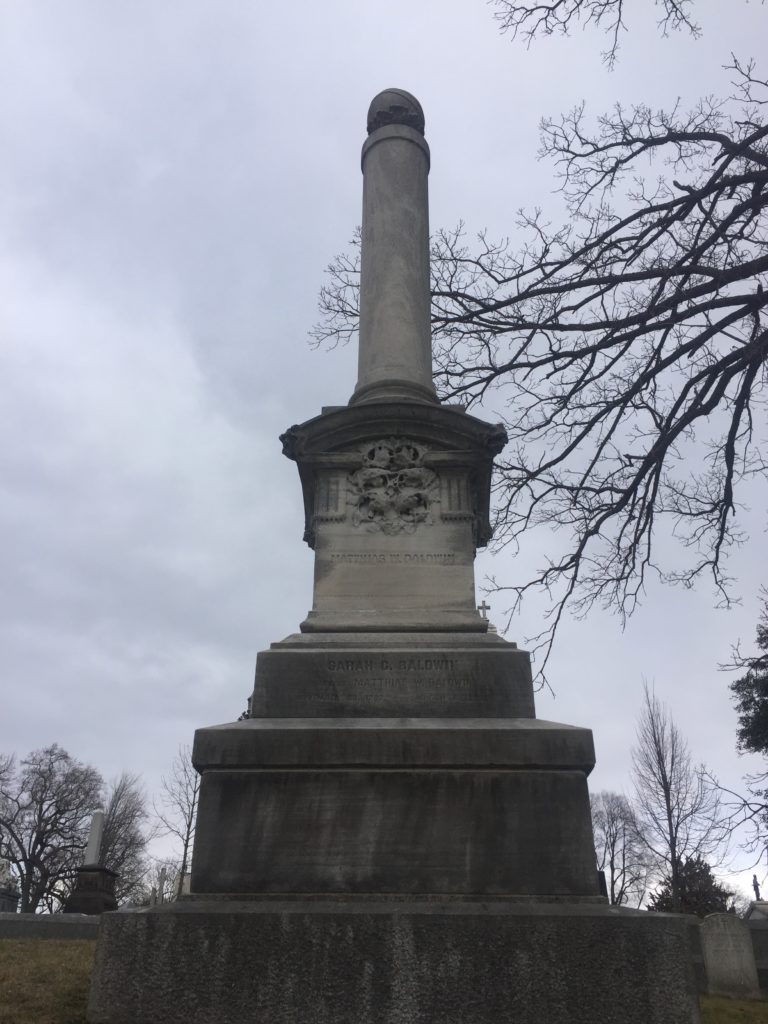Erik Visits an American Grave, Part 740
This is the grave of Matthias Baldwin.

Born in 1795 in Elizabethtown, New Jersey, Baldwin was wealthy as a small child. His father was a builder of fancy carriages for the rich and did very well for himself. But dad died in 1799 and the executors of the estate were incompetent. The money started dribbling away and by the time Baldwin was a teen, the family fortune was not in good shape. Young Matthias was a born tinkerer. As a child, he was known to take apart his toys to see how they worked and then put them back together.
In 1811, Baldwin was apprenticed out to a jewelry maker in Philadelphia. He remained in that position for the next six years. He was very good at this and started working on his own soon after, also becoming quite a silversmith. Soon, he developed a new technique for making gold plate, which became the standard because it saved a ton of time and labor and for which never bothered applying for a patent.
For some reason, the jewelry market collapsed in the mid 1820s. I’m not real sure why that was, but in any case, Baldwin decided to switch professions to something more steady. He and a partner started making printing equipment in the U.S. instead of importing it from Europe, saving a lot of money for publishers. Like in jewelry, he became an innovator in this field, creating a new process for etching steel plates. He also needed a bigger power source for the new firm. So he simply built a new and advanced steam engine for it that was the most powerful ever built. It is presently in the Smithsonian after powering his factory for the next 40 years.
Well, building engines was more profitable than working in the bookbinding trade. So Baldwin switched careers again. A new machine was being invented that would transform the world: the train. There are many people responsible for its early developments. One was Baldwin. In 1831, he created a steam locomotive that burned coal, which was easier to get in the Philadelphia area than wood. This was an experimental model that was on public display. The next year, the Philadelphia, Germantown, and Norristown Railroad asked him to make one of them that could work out on the tracks. While the initial trial worked, it also moved at 1 mile per hour. That obviously wasn’t going to work, but soon, advances in the technology improved it to 28 MPH, which is a whole other world, far faster than any form of transportation ever seen. He did get a patent for this and grew very, very rich. He started the Baldwin Locomotive Works, which did nearly go under in the Panic of 1837 like nearly everything else but which then became a hugely successful company.
The business did have its ups and downs. Increased competition by the 1850s meant that Baldwin had to pay his workers more in order to keep them by giving them piece-rate pay to incentivize them working harder, His trains became the coin of the realm by the late 1840s. The Civil War nearly did him in again and his heaviest investments were at that time in the South, but then the federal government gave him big contracts to produce engines for it and he got even wealthier. Along with Rogers Locomotive in New Jersey, it was the largest train maker in the nation at the time of Baldwin’s death in 1866.
Baldwin was also an abolitionist, built a Black school in Philadelphia and paid for its teachers for years. He also supported Black suffrage. While he was building a lot of railroads in the South, his competitors used his politics against him to try and get the contracts for themselves. Unfortunately, in the summer’s attacks on racist statues, someone vandalized Baldwin’s statue in Philadelphia, spray painting it with “colonizer” and “murderer.” Well, that’s unfortunate, though in any revolution a few eggs are going to be broken and it’s just a statue after all. Still, it would be useful if we all knew more history so that such attacks could be targeted more appropriately.
Matthias Baldwin is buried in Laurel Hill Cemetery, Philadelphia, Pennsylvania.
This grave visit was sponsored by LGM reader contributions. Thanks! If you would like this series to visit other Americans involved with the railroad industry, you can donate to cover the required expenses here. Frank Sprague is at Arlington and Eli Janney is in Alexandria, Virginia. Previous posts in this series are archived here.


